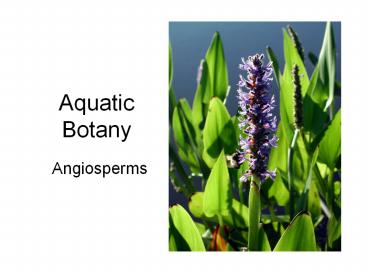Aquatic Botany - PowerPoint PPT Presentation
Title:
Aquatic Botany
Description:
Aerenchyma. American Burreed, Sparganium americanum. Purple Loosestrife. Floating-leaved Plants ... aerenchyma. often long petioles; often covered with mucilage ... – PowerPoint PPT presentation
Number of Views:400
Avg rating:3.0/5.0
Title: Aquatic Botany
1
Aquatic Botany
- Angiosperms
2
Hydrophytes
- Plants growing in water or on a substrate that is
at least periodically deficient in oxygen as a
result of excessive water content.
3
Categorizing Wetland Plants for Delineation
Purposes(p. 755 of Mitsch)
- Obligate Wetland (OBL)-occur almost always (gt99)
in wetlands E.g., Typha latifolia, Cattail - Facultative Wetland (FACW)-occur usually (67-99)
in wetlands, but also occur in non-wetlands
(1-33) E.g., Onoclea sensibilis, Sensitive Fern - Facultative (FAC)-similar likelihood of occurring
in wetlands and non-wetlands (33-67) E.g.,
Euthamia graminifolia, Grass-leaved Goldenrod - Facultative Upland (FACU)-occur sometimes in
wetlands (1-33) but more often in non wetlands
E.g., Quercus rubra, Red Oak - Obligate Upland (UPL)-occur rarely (lt1) in
wetlands e.g., Dennsteadtia punctilobula,
Hay-scented Fern - (/- may be appended)
4
Categorizing Wetland Plants by Growth Form
- Emergent-with leaves that extend above the water
surface e.g., Northern Blue Flag, Iris
versicolor - Free-floating-float freely on the water surface
e.g., Duckweed, Lemna minor - Floating-leaved-leaves float on water surface
e.g., Spatterdock, Nuphar variegata - Submersed-most of leaves growing under water
surface e.g., Curly-leaf Pondweed, Potomogeton
crispus
5
Emergents
Blue Flag Iris
Cattail, Typha sp.
6
Emergents
- tolerate fluctuating water levels
- may dampen shoreline wave erosion stabilize
sediments with interlocking rootbed of rhizomes - usually with protective waxy cuticle
- leaves with aerenchymous tissue making them
buoyant, useful for waterfowl nests - may reproduce aerially (flowers) or vegetatively
by rhizomes
7
Aerenchyma
8
Purple Loosestrife
American Burreed, Sparganium americanum
9
Floating-leaved Plants
Water Meal, Wolfia sp.
Giant Duckweed, Spirodelia
10
Floating-Leaved Plant Community
- cirucular/eliptical leaves with smooth margins
resist tearing - leathery thick cuticle (waterproofing)
- stomata on surface
- aerenchyma
- often long petioles often covered with mucilage
- may reproduce from flowers or by extensive
rhizomes - free-floating plants produce turions to overwinter
11
Fragrant White Water Lily, Nymphea
Spatterdock
12
Submersed Plant Community
- leaves flexible, often finely divided provide
structure for invertebrates - no cuticle often limp-the water provides support
- heterophylly is common
- stems photosynthesize
- some reproduce from seed, others by turion,
rhizomes, or tuber
13
Submersed Plants
Naiad, Najas sp.
14
Elodea canadensis
15
Pondweeds, Potomogeton sp.
16
Carex
Bristly Sedge, C. comosa
Tussock Sedge, Carex stricta
17
Juncus
Soft Rush, Juncus effusus





























